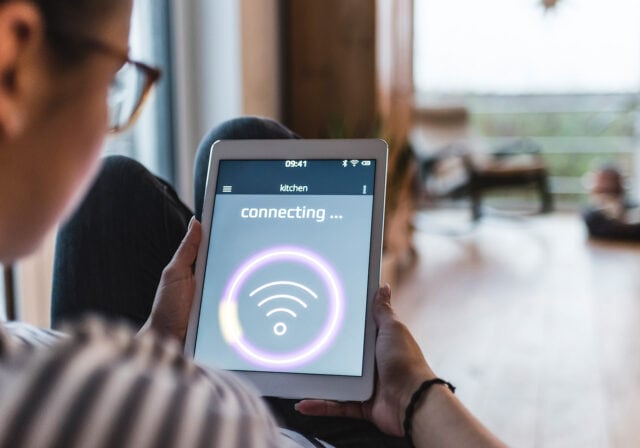1. Have a backup plan
No matter how reliable your internet service provider (ISP) is, occasional outages can happen. Having a safety net in place ensures that you have a lifeline when your primary connection goes down.
- Backup internet service: An internet backup plan is one of the easiest ways to stay connected when your primary service fails for whatever reason. The idea is to have an internet plan from a different ISP in place so you can switch over if something goes wrong. You may be thinking—isn’t that like paying for two home internet plans? Not really. These plans are usually much cheaper (and come with less data) since you only use them for a short period of time. Just remember, these are only temporary fixes, and will not replace your main connection long-term.
- Mobile phone as a hotspot: If you have a smartphone, you could use your phone as a hotspot to connect your devices. However, tethering devices can quickly use up the data included in your plan, which could result in additional charges to your monthly bill. Beyond data charges, some carriers also charge extra for the act of using devices as mobile hotspots and place restrictions around how personal hotspots can be used. So, it’s a good idea to check with your provider in advance—and check your data plan.
- Dedicated hotspot: There are also standalone mobile hotspots that offer backup internet. These devices often have more data capacity and stronger signals than your phone, and you can connect more devices to them during an outage. Some also allow for external antennas to boost the signal in areas with weaker reception. But, again, you’ll probably need to invest in a good data plan to make the most of this option.
2. Take an honest look at your home setup
If outages are being caused by something on your end, it’s time to look at your home network infrastructure. If your equipment is outdated, you have a lot of obstacles in your home, or the area you live in is a Wi-Fi dead zone, you’re going to have connectivity issues.
- Upgrade your router/gateway: Newer routers/gateways support higher speeds, better security, and can handle a lot of connected devices more efficiently. Make sure your router is up-to-date and capable of supporting your household needs during an outage.
- Set up a mesh network: If you have a larger home, or perhaps an unusual layout with thick walls or a lot of obstacles, Wi-Fi signals can be patchy. A mesh setup can improve coverage by spreading Wi-Fi signals across one or more nodes, making sure you stay connected even in remote corners of your space.
- Consider a wired connection: If you happen to live in an area with spotty Wi-Fi coverage, Fiber Internet could be a great solution. It’s different from traditional ethernet cables in that fiber-optic lines send data via light signals, giving you what may seem like warp-speed capabilities. In addition, with Fiber Internet, you usually get equal speeds for uploads and downloads, whereas cable often has far less uploading power. It may be just what you need if you have a lot of people in your home who are sharing large files, playing games, working online, streaming, or backing-up a lot of data in the cloud.
3. Have backup power on hand for your devices
Even if there’s no internet outage, a power outage can render useless the devices you need to stay online. Ensuring your connected devices stay juiced-up during a power outage is key.
- Uninterruptible power supply (UPS): Having a UPS in place before an outage can save you a lot of headaches. A UPS looks a lot like a power strip, but it’s also a surge protector and a battery backup in one that can keep your router, modem, computer, and other essential devices running during short-term power outages. For example, you can plug a UPS into an outlet, and then plug your computer into the battery/surge plug on the UPS. Not only does this protect against power surges, but when there’s an outage, the UPS automatically switches on and uses its battery to keep your electronics running for a period of time. Depending on the type, a UPS could give you anywhere from a few minutes to a few hours of backup power, so you have enough time to switch to backup internet or safely shut down your devices.
- Portable power station: In the case of longer outages caused by weather or other emergencies, having a portable power station on hand to keep everything charged is a lifesaver. A high-capacity power station is basically a light, portable battery (with plenty of outlets) that you can carry around and use to keep your phone, tablet, laptop, and other electronics in your home (like your coffee maker!) up and running even if the power goes out. Not only is it nice to have one during outages, but it’s also a great tool to bring on camping trips and other off-the-grid adventures. Some even come with built-in solar panels for charging.
- Portable solar panels: Live in a sunny location? A solar-powered charger can help keep your essential devices running during outages. These are basically small, often foldable solar panels with handles and built-in outlets for charging phones, laptops, and other devices. Of course, plenty of sunshine is key to their effectiveness.
4. Prioritize essential devices and services
During an internet outage, you may need to prioritize certain activities or devices based on what’s most important to your work or personal life. Having a plan will help you stay productive and avoid frustration.
- Prioritize devices: Decide which devices absolutely need to stay online during an outage. For example, let’s say your main Wi-Fi goes out, but you can still use your phone’s hotspot. If you're working from home, your laptop may be the most important tool, while other devices like smart cameras can be put on hold. If you just connect everything to your hotspot, it’ll drain your phone battery, eat up data, and slow everything down.
- Set up a workaround for communication: Have alternative communication methods ready for staying in touch with colleagues or clients. For example, if you’re working on your computer and your internet goes down during a crucial meeting, having phone numbers, messaging apps (e.g., WhatsApp, Slack), and video conferencing alternatives like Zoom or Microsoft Teams on your mobile device is a smart idea.
5. Download critical documents and media for offline use
When your internet goes down, access to important documents or content stored in the cloud can become unavailable. To avoid disruptions, it's essential to download key files and media to your devices in advance. This way, you can still access your important information and enjoy entertainment, even when you're offline.
- Download critical documents ahead of time: Whether it’s work files, medical records, or personal documents, make sure you have copies stored on your local device. Cloud services like Google Drive, Dropbox, or OneDrive are a great way to store and access documents, but they also require an internet connection to work. To prepare for an outage:
- Use the "Offline Mode" features in these services to sync files locally. For example, Google Drive lets you select files or folders to download for offline access.
- Save important documents like tax forms and medical information in a dedicated folder on your computer or an external hard drive. This way, you'll have them ready even if the internet is down for an extended period.
- Download your contacts: You probably use some sort of cloud service to store your contact lists, too, but like those other important files, they can be inaccessible without an internet connection. Be sure to export your contacts from your email or phone and save them as a Comma Separated Values (CSV) file on your computer or to a USB drive. This way, if an outage occurs, you can still access phone numbers, emails, and other important contact information from this basic text file.
- Download your favorite content: If you love streaming movies, shows, or music, it’s a good idea to download your go-to entertainment for offline use. Streaming services like Netflix, Spotify, and Amazon Prime let you download movies, TV shows, and playlists for offline access. This can keep you entertained and productive during an outage.
6. Regularly back up your data
Sudden outages can sometimes wreak havoc on your devices, causing system crashes or corrupted files. Having an updated backup of your critical files can protect against data loss in these situations, especially if you need to recover your work, photos, or personal documents after an outage or system failure.
- Cloud backups: Using a cloud storage service like Google Drive, iCloud, or OneDrive is one of the most secure and accessible ways to back up your data. These services can automatically sync your files, so you don’t lose valuable information during an outage.
- External drives and local backups: While cloud services are great, you can also keep important files on something more tangible, like an external hard drive, a USB stick, or Network Attached Storage (NAS). These devices can hold large amounts of data, and you can access them offline whenever needed. (Note: If you only have a couple of devices, NAS is probably a bit of overkill for the average household, as it’s pretty costly. But it may be a good solution if you run a small business out of your home.)
- Backup your system and settings: In addition to backing up files like photos, documents, and emails, it's essential to back up your operating system, system settings, and installed apps. This ensures that, in the event of a failure, you can restore your computer to its usual state without needing to reinstall everything from scratch.
- For Windows users, turning on Windows Backup helps you back up things like files, themes, settings, installed apps, Wi-Fi information, and beyond.
- If you’re a Mac user, turn on Time Machine, the built-in macOS tool that continuously backs up files including apps, music, photos, email, and documents for quick recovery.
- Check your system often: Just like testing your internet backup, you should routinely check that your backups are working. Be sure to check that files are being properly saved, and see if you can recover your data when needed. If you're using external drives, keep them in a safe location where they can’t be lost or damaged.
7. Conduct a drill
There’s nothing worse than realizing that your backup internet system or other preparations aren’t working when you need them most, which is why you should check your backup plan regularly.
- Test your backup connection: Regularly test your backup internet service or mobile hotspot so it’s ready when you need it. Check the speed, connectivity, and battery life to make sure you’re not caught off guard. You can do this by periodically disconnecting your primary internet connection (or turning off the router) and seeing how quickly you can switch to your backup system. This helps you practice the steps for a smoother transition during an actual outage.
- Check your power backup: Run a test sometimes to make sure your UPS, solar charger, power station, etc. is working as expected in case you need to rely on backup power during outages.
8. Stay in-the-know about outages
Knowing when and why an internet outage is happening can help you prepare in advance. For example, a planned, one-hour maintenance issue is a lot different from a major shutdown with no estimated time for repair.
- Sign up for ISP notifications: Many ISPs send out alerts or post notices about scheduled maintenance or outages in your area. Keep an eye on these notifications so you can plan for potential downtime.
For T-Mobile Home Internet users, the T-Life app will provide the most up-to-date news regarding network outages. T-Mobile Home internet troubleshooting tips are available here. For T-Mobile Home Internet users, the T-Life app will provide the most up-to-date news regarding network outages. T-Mobile Home internet troubleshooting tips are available here. - Use outage detection apps: There are apps that track internet outages across different providers. Apps like Downdetector can give you real-time updates about widespread disruptions, helping you stay in the loop.
While internet outages are a part of life sometimes, they don’t have to throw your world into chaos. By preparing ahead of time with a reliable backup internet service, a solid home network setup, power alternatives, and contingency plans, you can make sure you stay connected, productive, and entertained—no matter what comes your way.
T-Mobile offers several Home Internet options to help keep you connected, including T-Mobile Home Internet Backup, T-Mobile All-In with Mesh Access Point, T-Mobile Fiber, and more. Find a plan that works for you.
T-Mobile is not affiliated with, endorsed by, or sponsored by the third parties referenced in this post. All trademarks are property of their respective owners. Any references to third-party trademarks are for identification purposes only.
Learn More
How Does Internet Backup Work?
All Things Fiber Optic Internet Cables
What is Mesh Wi-Fi? A Beginner’s Guide
Sources:
- https://www.nytimes.com/wirecutter/reviews/best-uninterruptible-power-supply-ups
- https://www.popularmechanics.com/home/a32825530/best-portable-power-stations
- https://www.cybercollective.org/blog/how-to-prepare-for-an-internet-outage
- https://moldstud.com/articles/p-how-to-access-cloud-storage-without-an-internet-connection
- https://www.ablebits.com/office-addins-blog/export-outlook-contacts
- https://en.wikipedia.org/wiki/Comma-separated_values
- https://support.spotify.com/us/article/listen-offline
- https://www.nytimes.com/wirecutter/reviews/best-network-attached-storage
- https://support.microsoft.com/en-us/windows/back-up-and-restore-with-windows-backup-87a81f8a-78fa-456e-b521-ac0560e32338
- https://support.microsoft.com/en-us/windows/back-up-and-restore-with-windows-backup-87a81f8a-78fa-456e-b521-ac0560e32338
- https://support.apple.com/en-us/104984



